In this article, I help you to take an incisive look at the issue of "global warming", with special focus on carbon dioxide (CO₂), which has been pushed into the public consciousness since at least the release of Al Gore's 2006 documentary "An Inconvenient Truth", as THE cause of global warming. Be patient, the title will be explained.
After I saw that movie, I did a lot of research, talked to various experts, including Arctic expert Prof. Dr. Louwrens Hacquebord, the father of a colleague, and Prof. Dr. Sudharto P. Hadi, a neighbor of mine in Semarang, Central Java, Indonesia, as well as several people on LinkedIn, and did several presentations about climate change and how to mitigate our impact to various age groups - primarily university students. When I started looking at the issue of "global warming", part of the climate cycle, I was initially very concerned because of the movie. After I had spent some time on researching climate change, I learned about many things that all fit into the whole issue. It didn't take very long to put together the pieces of the very large puzzle and realize that the scope was much larger than the micro-focus of CO₂.
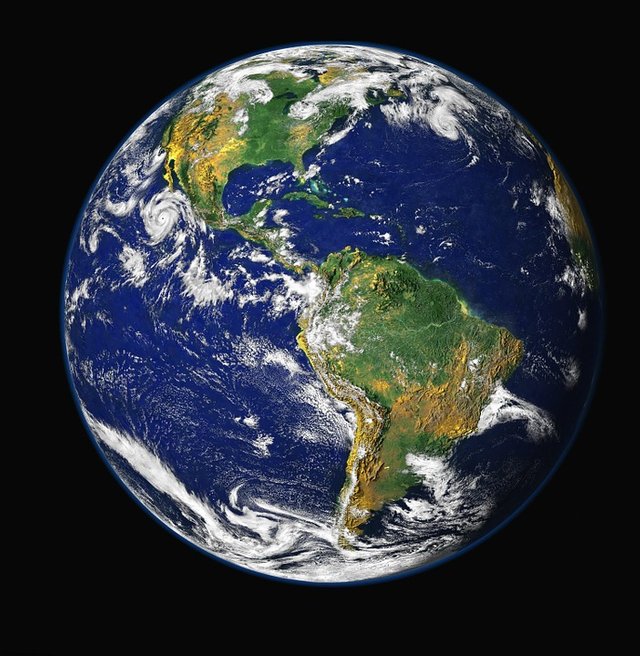
To understand the issue requires a degree of technical knowledge (or, at least, the ability to comprehend it) - a fair amount, actually - about a variety of natural phenomena, but we can focus on the albedo, greenhouse gases, Milankovitch's theory, other natural phenomena and human activity. There are many other factors that influence the global temperature, but the only other ones I want to address are the urban heat island and ****************. I intend to set the record straight without making it hard to understand. If you have questions, please put them in the comments and I'll address them, plus I'll try to add it up here if it's needed.
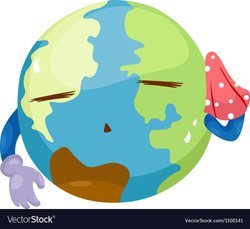
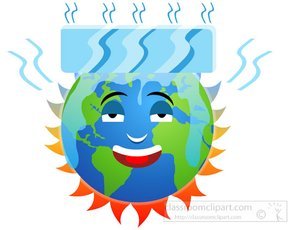
"Global Warming and Cooling"
"Global warming" has become such a buzzword that people don't even realize what it truly means. It is NOT what people think it is. Along with "global cooling", they describe the changes in temperature that are almost entirely caused by natural forces that are completely outside of our control. Think of global cooling in terms of glaciers and pretty much perpetual cold weather through most of the world beyond the tropics.
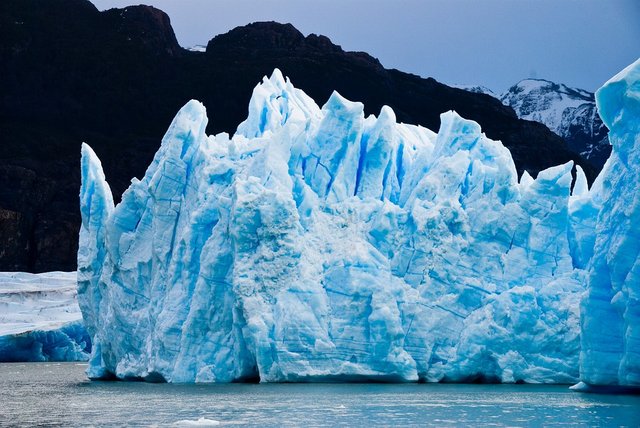
When the earth's temperature is low enough that it is dominated by glaciers, scientists call that a glacial period. The last one was about 15,000 years ago. Glacial periods are almost always extremely long - graphs use a scale of tens of thousands of years, or greater, and the global temperature is measured on a scale of around +/-6°C from 0. As you can see below, the last glacial period (Cycle II) lasted about 100,000 years, whereas interglacial periods usually last a fraction of that time - Warm II (the last interglacial period) only lasted about 25,000 years!
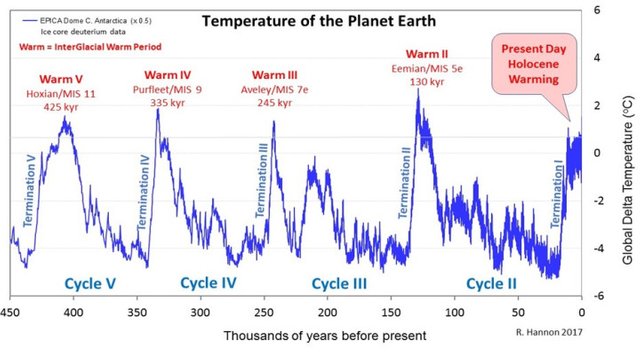
Global warming is the opposite. The global temperature spikes "rapidly" (over thousands of years), exceeding 0°C, and tapers off less rapidly. When the temperature gets high enough, glaciers recede from much of the planet's surface, although the Antarctic and mountainous regions tend to continue to have glaciers. As the temperature rises, more and more of the glaciers start to decrease in size and, in some regions, disappear entirely. This is completely natural and the misuse of the term has led people to believe it is somehow an unnatural, man-made (anthropogenic ) consequence.
Albedo
This is what causes the "greenhouse effect" and protects the Earth, too. In short, the albedo is any substance or object which has the ability to reflect heat. Some substances reflect heat back, while others let it pass through - those that reflect the heat include clouds, white buildings and snow. Hydrogen by itself, for example, doesn't really have any effect on solar radiation (heat from the sun), but when it mixes with carbon to form methane, it does. Think of the albedo as a giant mirror. Anything light colored will reflect light, as well as other substances that have ability to reflect heat can be considered part of the albedo. That includes glaciers and the polar ice caps, as well as light-colored deserts, which will become very hot as the heat is reflected off them and absorbed short-term, but quickly become cold at night because the desert terrain isn't made of things that hold heat for a long time. Anything dark will absorb light, increasing the temperature, and certain materials are very good at releasing the heat slowly. The oceans absorb more heat and hold it longer than any desert, which is important since it causes the currents, evaporation that turns into clouds and precipitation and contributes to air currents!
Some of the heat of the sun is reflected by the Earth's atmosphere simply because it hits the atmosphere at such an acute angle that it just bounces off. That's why dawn and dusk are cooler than the middle of the day - more heat is bouncing off, less is directly bombarding the planet on a perpendicular path, and much is just passing through the atmosphere and exiting from the far side. If you think your house gets too hot - take a look at the color of the external walls and roof, as well as how much rock, cement and asphalt are nearby!
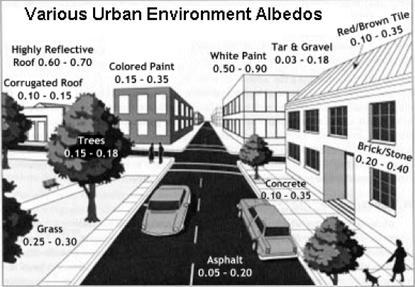
The smaller the number, the greater its potential for trapping heat
Plants have the ability to keep the temperature cooler, and even alter the climate. Large forests can actually generate fog and rain through their natural processes that use CO₂, and H₂O.
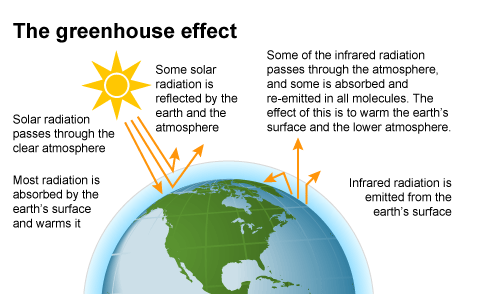
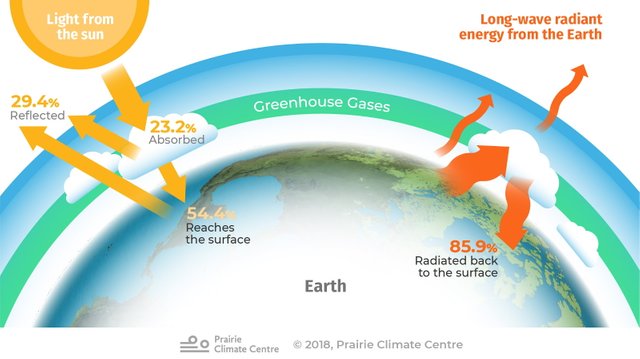
Greenhouse Gases
There are many kinds of gas, but some have the ability to contribute to the albedo. Al Gore told us about CO₂, but he was strangely silent about the other, more powerful, gases: nitrous oxide (N₂O), methane (CH₄), ozone (O₃), fluorinated gases [chlorofluorocarbons (CFCs) and hydrofluorocarbons (including HCFCs and HFCs)] and water (H₂O) vapor. While it is true that human activities produce more CO₂ than the other gases, the power of those other gases is much greater than that of CO₂, although the power of N₂O, CH₄ and O₃ decrease more rapidly over time due to chemical reactions in the air, the fluoride-based gases have an increasing impact over time because they do not. In other words, based on how long they remain in the air, as time passes the concentration is anticipated to decrease for those three but increase for fluoride-based gases. However, since these 3 gases (and water vapor) are produced both by humans and occur naturally (such as from swamps and the decay of dead plants and animals, including flatulence), we must still be concerned that, over a 20-year span of time, methane is 84 times more powerful and nitrous oxide is 264 times, whereas fluoride-based gases have thousands of times (4,880-17,500) more impact on the albedo. Ozone in the lower atmosphere has 49 times the global warming potential (GWP) of CO₂. The number vary between sources and change over time, so this is an approximation. Water vapor is the single most powerful greenhouse gas.
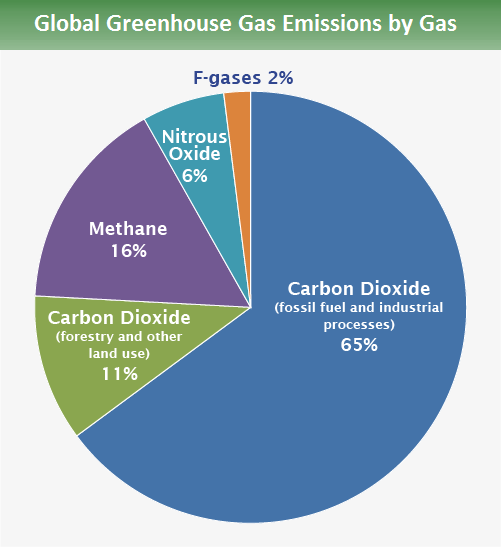
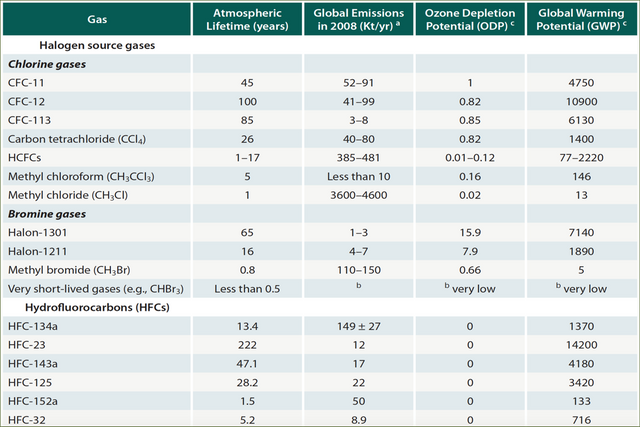
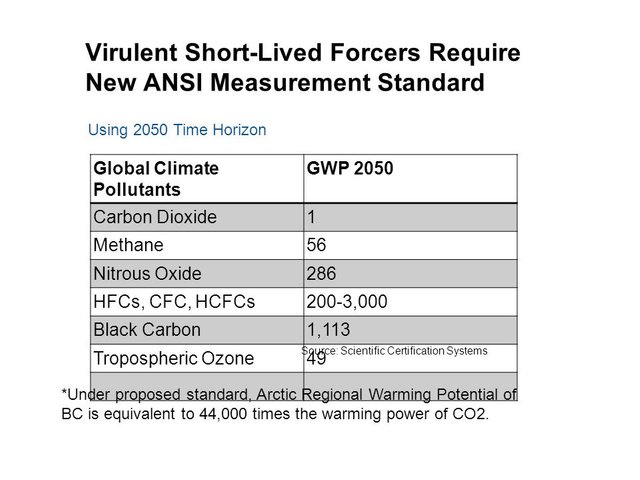
Milankovitch's Theory
Milankovitch, building on previous work, believed that the Earth's orbit, specifically its eccentricity (changes in the shape of the orbit), obliquity (the "tilt" of the Earth), and precession (wobbling of the Earth's axis), around the Sun, explains the changes in the climate to a large degree. Humans have no control over Earth's orbit, or the power of the Sun, do they? Yet, this is the single most powerful determinant of the climate!
Other Natural Phenomena
Natural things that impact the climate include:
- volcanic eruptions (ash increases the albedo when it's in the air, causing lower temperatures, but it can cause higher temperatures when it settles to the ground, especially on top of normally white areas like snow and ice);
- the heat from the Earth's core;
- the presence, size and thickness of glaciers and bodies of water;
- plants and plankton, and how much there are of them;
- animals, including humans, produce both carbon dioxide (breathing) and methane (farting);
- decay of dead lifeforms (organic waste), which produces methane;
- gas emissions from bodies of water, volcanoes, vents in the Earth's crust;
- air and water currents;
- the atmosphere, clouds and ozone;
- forest, brush and plains fires;
and many more factors, the majority of which we have little to no control over! As temperatures rise, methane trapped under tundra and in the oceans is released in larger amounts, too, coral bleaches and dies and plankton may also be negatively impacted by increasing temperatures in the oceans.
Urban Heat Island
Human building practices have a direct impact on local climate. It causes not just higher temperatures but also alters the local weather. Built-up urban areas have the highest summer temperatures, while undeveloped areas have the lowest (deserts have very high temperatures during the day and very low ones at night due to the inability of the local ecosystem to moderate the climate). The larger our urban and suburban areas become, the greater the overall impact on the climate.
The difference in temperature can be 3-10°F between rural and urban areas!
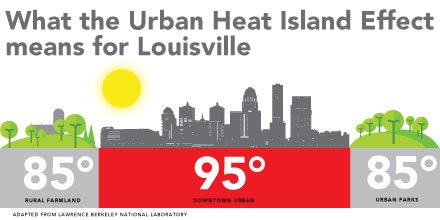
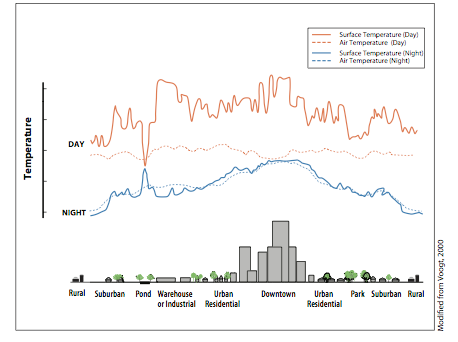
As you can see, the night-time air temperature is significantly altered, too. The reason for this is because the stone and metal we use traps and holds heat longer than natural areas. Windows refract and reflect light so that it goes further down into areas dominated by skyscrapers, increasing the amount of the heat in the sunlight that is captured. Less water evaporates because most of the land is paved over, which reducing water absorption and humidity. The lack of plant life further impacts city temperatures because plants actually help to moderate the climate. Using dark materials for buildings' walls and roofs further increases the temperature.
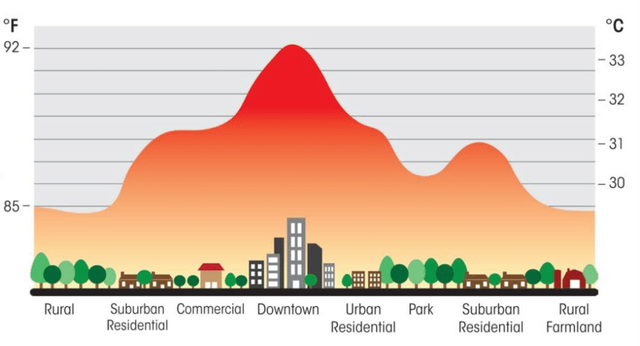
Human Activity
What about the hubbub over what we humans do? Well, first of all, we have to understand that there are MANY things that we do which impact the environment, including fires, deforestation, dumping waste into waterways (which creates vast dead zones in rivers, lakes and oceans), manufacturing, ranching, warfare, transportation, cement production and usage, waste disposal and decay, cooking and even farting! The larger the scale and the more powerful the gases produced, the greater the impact. In addition, things like soot and other dark precipitates also contribute to warming when they fall out of the air and settle on surfaces - especially if those surfaces were originally very light in color and not able to absorb and retain heat well. As our population has grown, almost all activities that have a warming effect on the environment have increased over time, with the real increase occurring after the industrial age commenced, and expanding as more and more countries have moved to using technologies that contribute badly to the climate. We don't just produce CO₂, we produce all of the various greenhouse gases in varying amounts and some, as we realized how bad they were for the atmosphere and the environment, have been or are being phased out of use, but common ones like water vapor, carbon dioxide, nitrous oxide and methane continue to be produced.
Conclusion
Some people claim that humans have no impact whatsoever on the climate yet I can immediately offer you three proofs:
- The urban heat island is the consequence of human building practices, and clearly demonstrates a consequence of our actions - increased heat compared to a natural area like a wildlife preserve.
- In addition, math teaches us that when something is added, no matter how minute it is, it has an impact on the total.
- Finally, physics teaches us that each system has an impact on every other system, whether it be directly or indirectly. Colloquially, "if a butterfly flaps its wings on one side of the world, a typhoon happens on the other side." I find this rather an extreme example, so let us stick with reality instead. If you throw a rock into water, there is a splashing sound, perhaps a "kerplunk!", and water splashes upwards as the rock drags bubbles of air downwards. Ripples immediately start to travel across the surface from the impact point and, depending on what they hit, how far away it is, and how strong the ripples, wind and current are, ripples may bounce back or they may bounce off in another direction. If, for example, there are lily pads floating on the surface, they will rock and both deflect the ripples and create new ripples from this collision. A frog on a lily pad, disturbed by the event, jumps into the water to escape what it thinks is danger, which creates new ripples. As it dives, it startles a fish that launches itself into the air, creating ripples, and even more ripples are made when it lands. The chain of events may continue...all caused by you throwing a rock into the water.
- Al Gore's motivation had less to do with the climate and more to do with swaying public opinion in order to make himself rich. He was already set up to be part of the system that would handle carbon dioxide trading. He didn't deserve that Nobel prize!
- Data about the Earth's global temperature had been "massaged", which is to say that people either deliberately miscalibrated the temperature sensors around the globe, or they changed the results to support the new industry that Al Gore was the face of. Perhaps both occurred. I am not prepared to speculate on who was involved in this conspiracy, whether the IPCC itself orchestrated it, it was beneath the radar, or a global organization was behind the deceptions.
- The first clue, for me, was that CO₂ is not even the top greenhouse gas nor, indeed, was it that significant compared to the other greenhouse gases. The fact that there is a great deal more of it in the atmosphere is a natural phenomenon that shouldn't be pointed at as a smoking gun.
- Not all environmental scientists agree with the IPCC, despite the implications bandied about that 90% of scientists agree. Climate science is a very difficult field of study to master because of the vast number of variables, and many of the scientists who agree with the IPCC are NOT climate experts and are thus less (or not at all) qualified to state their opinion on this matter.
- Covering land with cement, buildings and asphalt also decreases underground bodies of water (in aquifers and caves), increases problems with flooding, run-off of chemicals (oil, pesticides, herbicides and other poisons, etc.), and decreases the availability of fertile soil (which dies when it is covered for long enough.
To say that anthropogenic (man-made) factors are the main contributors to the climate is a terrible lie, but to say that humans have NO impact on the climate is also a terrible lie. It may be hard to pinpoint just how much our actions impact the environment but one thing is clear - we DO affect the climate. To do nothing is sheer idiocy, but to put all our effort into just dealing with carbon dioxide is a fool's errand.
Now, to address my title, which is not accidentally "in quotemarks".
If CO₂ were such a big deal, why wouldn't we focus on getting rid of carbonated beverages - surely there is no need to continue to carbonate beverages if CO₂ is such a major threat? Yet production continues to increase for all carbonated beverages! So, I apologize that my title was a bit misleading, but I hope now you understand better about climate change! If you have questions or comments, please write them!
If you appreciate this article, please 🏅upvote/like👍 , 🤩resteem/share
, 🤩resteem/share and share it to Facebook
and share it to Facebook , Twitter
, Twitter , Reddit
, Reddit , LinkedIn
, LinkedIn and wherever else
and wherever else you can!
you can!